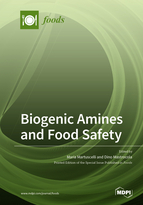Biogenic Amines and Food Safety
A special issue of Foods (ISSN 2304-8158). This special issue belongs to the section "Food Quality and Safety".
Deadline for manuscript submissions: closed (30 September 2020) | Viewed by 46418
Special Issue Editors
Interests: biogenic amines; food quality; by-products
Special Issues, Collections and Topics in MDPI journals
Interests: Maillard reaction products; lipid oxidation; antioxidant activity; enzymatic browning
Special Issues, Collections and Topics in MDPI journals
Special Issue Information
Dear Colleagues,
The purpose of this Special Issue on “Biogenic amines and food safety” is to focus on biological, technological, and environmental factors affecting the occurrence of biogenic amines (BA) in foods from animal and vegetable origin. The presence of BA in foods is quite frequent and inevitable. BA can be naturally present, derive from the decarboxylation of amino acids by enzymes of microbial origin, or be produced by the transamination of aldehydes by amino acid transaminases. This Special Issue will discuss two aspects of BA in food: 1) BA concentration as a quality index of processes and of raw materials, intermediates, and end products; 2) the risk of creating toxic reactions associated with BA, considering the composition of a whole meal as well as the specific physiological conditions of the consumer. The knowledge of BA levels in foods is important to both consumers and producers, therefore papers discussing the possibility to establish a regulatory system containing food safety criteria for BA, as already existing for histamine in fishery products, are also welcomed.
Prof. Maria Martuscelli
Prof. Dino Mastrocola
Guest Editors
Manuscript Submission Information
Manuscripts should be submitted online at www.mdpi.com by registering and logging in to this website. Once you are registered, click here to go to the submission form. Manuscripts can be submitted until the deadline. All submissions that pass pre-check are peer-reviewed. Accepted papers will be published continuously in the journal (as soon as accepted) and will be listed together on the special issue website. Research articles, review articles as well as short communications are invited. For planned papers, a title and short abstract (about 100 words) can be sent to the Editorial Office for announcement on this website.
Submitted manuscripts should not have been published previously, nor be under consideration for publication elsewhere (except conference proceedings papers). All manuscripts are thoroughly refereed through a single-blind peer-review process. A guide for authors and other relevant information for submission of manuscripts is available on the Instructions for Authors page. Foods is an international peer-reviewed open access semimonthly journal published by MDPI.
Please visit the Instructions for Authors page before submitting a manuscript. The Article Processing Charge (APC) for publication in this open access journal is 2900 CHF (Swiss Francs). Submitted papers should be well formatted and use good English. Authors may use MDPI's English editing service prior to publication or during author revisions.
Keywords
- biogenic amines
- food
- safety
- quality
- food process
- health
- toxicity
- pharmacology
- risk assessment
- risk management







